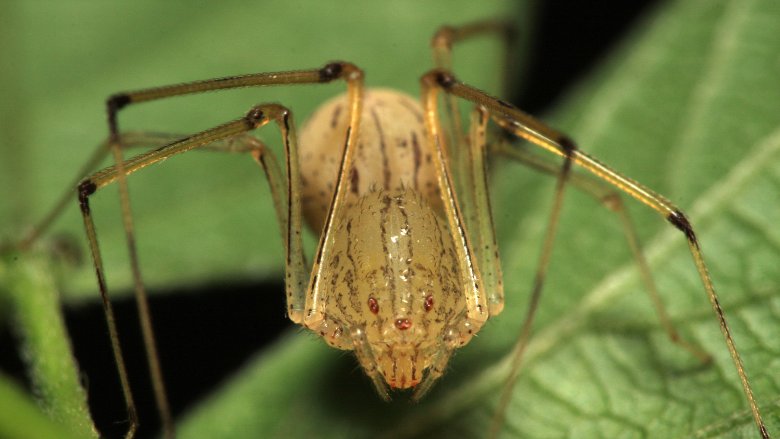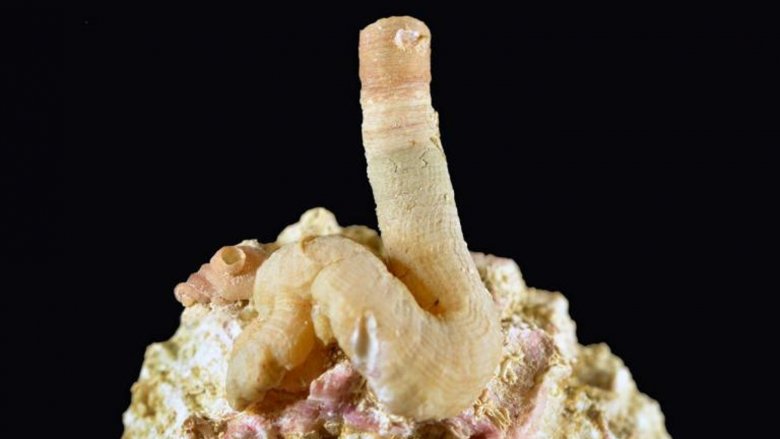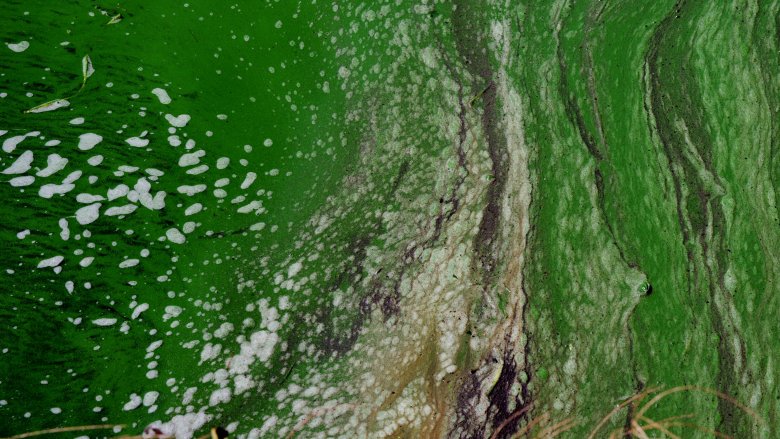Real-Life Slime Attacks That Will Give You Nightmares
Slime is irrefutable proof that hell is real and really gross. It's sticky, gooey, icky, and usually produced by a brain-curdling bio beast. The very thought of slime and its ghastly purveyors can induce crippling insomnia and spontaneous screaming. So naturally, you should read an entire article about them. Just be sure to brace your stomach. A plate of viscous trauma is coming your way.
One fish, ew fish, dread fish, spew fish
Found and feared throughout the globe, hagfish are deep sea monsters that look the way unhappiness feels. They have serpentine torsos and heads covered in thorny protrusions. Their jawless mouths are unspeakable. And when they aren't busy being ugly, the underwater monstrosities are spewing unctuous gunk all over the place. But why? Why would anything be that disgusting?
Ecologist Andrew David Thaler explained to Gizmodo that the fish spew goo for two basic reasons. Firstly, it serves as a deterrent to would-be predators. In human terms, it's like blowing your nose in a bear's mouth. Secondly, when hagfish get the munchies, they coat their meal with mucus so nothing else will eat it. That sounds like the vilest lunch ever, but hagfish phlegm is pretty exciting scientifically. The stuff is so strong and durable that experts have considered trying to convert it into clothing (for masochists probably).
The hagfish's horrible bioweapon has inspired charming nicknames like "snot snake" and "slime eel." And in July 2017, it earned yet another catchy moniker: road ruiner. That honor came courtesy of a truck transporting 7,500 pounds of those unsightly ocean gremlins. As the Washington Post elaborated, the vehicle tipped over and lost its load, hemorrhaging snot snakes and their snake snot all over the place. This caused five presumably frightened drivers to crash into each other as fish mucus engulfed them and their unlucky stretch of highway. On the bright side –- just kidding, there is no bright side.
Glue velvet
Likening something to velvet makes it sound cuddly. So you'd be forgiven for assuming that "velvet worm" describes a children's toy. In reality, putting a velvet worm in a kid's hands would doom the youngster to years of therapy. And if you think that's an exaggeration, just play the above YouTube clip and prepare to never smile again.
The clip features a velvet worm stalking a beetle. Immediately you see that the worm has a gangly body, a bunch of legs, and a face no mother could love. To trap its prey, the worm unleashes a torrent of sticky slime. It then stabs its victim with a mandible dagger before liquefying the bug's insides with caustic saliva and enjoying a beetle smoothie. Gross portions (so essentially all of it) aside, that sequence is pretty incredible. What especially stands out is that unlike most goo gushers, velvet worms can fire oscillating slime streams without moving their heads.
For over 100 years, science couldn't explain this ability, presumably because all the researchers who witnessed it quickly stapled their eyes shut. But in 2015, National Geographic announced a breakthrough. A spate of experiments showed that the velvet worm has contracting ducts that squeeze mucus through a narrow conduit. Slime sprays forth like water through a hose before the worm ultimately drinks its victim. If that freaks you out, just steer clear of the little devils. They're typically found in Australia, New Zealand, the tropics, and under your pillow.
Along came a spitter
People like to compare spitting spiders to Spider-Man because nothing in this world is sacred. The two basically have nothing in common. Spitting spiders, for instance, look awful wearing glasses. And Spider Man doesn't eat insects. Moreover, the only thing venomous about Spider Man was, well, Venom. Spitting spiders, by contrast, hawk venomous goo loogies and are far more terrifying than amazing.
Drawing from National Geographic's documentary Super Spider, Nerdist described the innards and outflows of expectorating arachnids. Their strange ability derives from having an extra web duct which contains an amalgam of silk, glue, and venom. So rather than waiting patiently for food like a typical web-weaver, these eight-legged assassins take their snares with them. Once they pick a bug from Nature's menu, they position their fangs like tiny pistols and bombard their target with death paste. The lethal slime stream travels at up to 62 miles per hour and contracts on contact, sealing both the victim and its fate.
It's hard to imagine something worse than a machine gun arachnid with toxic ammo. But Nature works in misanthropic ways and has already invented a scarier alternative: slime-slinging gangs. According to National Geographic, Singaporean spitting spiders hunt in groups when they're young. Once they're old enough to leave the nest, which in this case is a web, younglings massacre insects in units of four or more. As time passes, they mature into lone gunmen, capping fools with their oozy Uzis and occasionally eating each other.
Shelled shock
Snails typically resemble sentient eye crust and move like cold molasses. But not all of them fit that description. Some snails stay completely still while grossing people out. Case in point: the worm-snail. Long unknown to scientists, the snails made headlines in 2017 after a surprise discovery. And once you learn how these creatures survive, you'll wish they'd stayed unknown.
As detailed by National Geographic, worm-snails live underwater and cling to fixed surfaces like barnacles with abandonment issues. Identified as an invasive species, they hail from the Pacific but ostensibly moved to Florida for retirement. The worm-snail's name derives from its long, spindly shell, which looks like rotting rigatoni and comes in a variety of festive colors. And while this may make the animal sound endearing, know that it's really a sci-fi monster disguised as sea pasta.
See, because worm-snails don't move, they have to let meals come to them. And since no creature wants to be seafood, Nature has armed the immobile gastropods with pretty revolting weapons. Specifically, they have two wriggly appendages that cast mucus nets. When a microorganism gets caught in a net, the worm-snail sucks the whole lot into its mouth, where that microorganism gets strained to death by tongue spikes. In other words, the worm-snail is a snotty meat grinder that eats its own boogers. (And now you can associate murder mucus with sausages and hamburgers. You're welcome.)
Yuck in the middle with you
Fans of aural discharge have probably heard of otitis media, a bacterial infection of the middle ear. Marked by fluid buildup, impaired balance, pain, and general yuckiness, otitis media afflicts millions of children annually. Physicians have historically treated the ailment with antibiotics. But as noted by Science Daily, symptoms keep resurfacing in some children, haunting their ears like a bored, lonely ghost. Experts initially blamed this on separate instances of infection, but in 2006 they concluded something far worse.
Researchers at three U.S. hospitals formed a science Voltron to determine the cause of recurring ear infections. As it turns out, the answer is ear slime. Bacterial communes, or biofilms, besiege children's ear canals by deploying a nigh-impenetrable mucus shield. The tactic is so effective that even antibiotics prove futile, leaving drainage tubes as the only (somewhat) viable defense. That's right. For all its dazzling sophistication, modern medicine can't outwit slime.
Before you cram a box of Q-tips in your ears (and make it worse), keep in mind that not every infected head has invincible mucus living in it. Acute but nonrecurring versions of the malady still respond to antibiotics. And even in chronic cases, researchers didn't always find biofilms –- only 92 percent of the time. If you assume that figure applies generally, then even if you grew up with super sickly ears or have them now, you might belong to the lucky 8 percent in the clear. You'd still have painful, leaky ears, but at least you don't have slimy, painful leaky ears.
Upsetting stomach
Florida is the Noah's Ark of invasive species. Everything from gargantuan pythons to stucco-eating snails has settled there, causing all manner of mayhem. Of the Sunshine State's many intruders, the New Guinea flatworm easily qualifies as one of the nastiest.
A mere 2 inches in length, the creature sounds adorably unassuming. In fact, it looks like an overgrown sweaty eyelash. But as outlined by the Miami Herald, it's a Pandora's box of biological horror. The flatworm wears a coat of toxic ooze and hosts a brain parasite that's communicable to humans. Touching one is a disastrous idea. Moreover, it can reproduce asexually, making it immune to abstinence-only education. And lest you think it can't get any worse, you should also know it has an abdominal mouth.
Having a belly-mouth would be inconvenient for us but not for New Guinea flatworms. For the animals they eat, that organ might as well be a torture device. The odd anatomical placement allows these flatworms to cough up their own stomachs, which ooze deadly acid. That comes in handy when they get hungry for escargot. In order to bypass snail shells, they simply puke their guts out and let their puked guts do the rest. Remember Florida's stucco-eating snails? Those things are the length of human hands, and New Guinea flatworms gang up (in packs of 30 to 40) to eat them. Go ahead and take a moment to digest that thought.
The grave slobber
Audrey II notwithstanding, humans usually view plants as decorations or salad. Exceptions like poison ivy exist, but even those get treated more like nuisances than nightmares. That portrait of harmlessness fades, however, once you enter the world of carnivorous plants. Once you meet the pitcher plant, the picture gets Dorian-Gray-ugly.
Native to tropical Asia, pitcher plants are nature's lethal ale horns. Only, rather than holding alcohol, they function in ways that make you want to drink to forget. As per Science Daily, the plants produce sweet nectar that brings all the bugs to their yard. Bugs approach their basins, enticed by the promise of a lovely snack. Instead, they become the snack. Any creature unfortunate enough to enter the plant slides helplessly into a pit of digestive slime that dissolves the victim and swallows it like quicksand. The more it resists, the faster it sinks into oblivion.
Suddenly, Audrey II doesn't sound so vicious. She seems downright affable compared to the Nepenthes attenboroughii. Named for the great David Attenborough, this species of pitcher plant resides in the Philippines, where it devours full-sized rats, according to The Telegraph. Christian missionaries stumbled across the plant in 2000 and presumably broke into uncontrollable sobbing before telling experts what they saw. Seven years later, a British research team scaled a mountain to confirm the eco rat trap's existence. Had this been a horror flick, those scientists would have become plant food. Perhaps some of them did.
The ant-churean candidate
People regularly use the term "parasite" to deride freeloaders who wouldn't lift a finger to save their own lives. Biological parasites, however, resemble anything but. Devious and devastating, they often seem less like zeroes and more like nature's 007s. Enter the lancet liver fluke. Like its name alludes, the parasite inhabits the livers of herbivores such as cows and occasionally humans, according to the Centers for Disease Control. The liver fluke lacks James Bond's cadre of women, fancy gadgets, and unearthly alcohol tolerance, but it absolutely owns the super-spy in one regard: mind control.
To ensure their offspring know the joys of liver living, the flukes employ viscous subterfuge. They begin by laying eggs in cow poop, which various snail species eat. (Yum.) The snails undoubtedly regret this decision, as they now have to expend energy encasing baby parasites in slime balls and expelling them. Ants, which apparently have the appetites of preschoolers, see the slime balls and think, "Gee, that looks tasty." As further elaborated by National Geographic, once ants ingest the tainted upchuck, the young flukes commandeer their new hosts' brains. The eventually command their arthropod puppets to climb atop blades of grass so that grazing animals can eat them.
Once you've stopped gagging, you'll probably wonder how the crafty liver fluke worms its way into a human. The answer's simple: just eat an ant with parasites in its brain. If you can resist that temptation, you'll probably be fine.
Until you're bloomed in the face
The Blob is a 1958 creature feature about marauding space goop that insatiably eats its surroundings. As it tears its way through humanity, the interstellar jelly continually increases in size. Unsettling, right? Well, guess what. Earth has its own Blob equivalent: algae. That might sound preposterous initially, but when you discover how it rolls, you may change your mind.
Consisting of countless microbes, algae grow in ponds, lakes, and oceans across the world. As noted by the Washington Post, when algae form vast colonies known as blooms, they thicken water to a soupy consistency. That sounds like cause to grab a large spoon and some seasoning, but you'd be eating it at your own peril. Blue-green algae, for instance, boast an infamous fluorescent hue that gels with their otherworldly ability to poison waterways on an epic scale.
Utah's inventively named Utah Lake suffered a massive algae bloom in 2016 that caused 130 cases of skin rash, vomiting, and butt fudge. That same year, USA Today reported that the microbes forced Florida to declare a state of emergency. The outlet additionally mentioned that algae toxins may spur Alzheimer's and Parkinson's disease. And just think: they're everywhere. According to National Geographic, toxic algae were implicated in the 2015 deaths of over 300 whales near Chile. In South Africa, they murdered enough salmon to fill 14 Olympic swimming pools. And as global temperatures rise, these tiny terrors of the sea could grow even more pervasive.
Scream of the crop
Serratia marcescens is the scientific term for that reddish goo that accumulates in people's showers and toilets. This stomach-churning slime layer is a type of biofilm, which you may recall as the kind of growth underlying chronic ear infections. Luckily, Serratia marcescens seems to have little interest in your ears. According to water quality specialist Roxanne Johnson, it's more likely to give you pneumonia or a urinary tract infection. It also just gave you an excuse not to bathe.
These rosy bacteria thrive in moist environments and aren't super picky about where they live. When they aren't watching you use the bathroom, they can be found making holy symbols bleed. As explained by Scientific American, historical reports of religious statues and communion wafers shedding blood likely stemmed from crimson slime colonies trickling from their moist surfaces. That's some Exorcist-level chicanery right there.
The biofilm's biggest claim to horror fame, however, came in 1819 when the bacteria ravaged stores of Italian polenta corn meal, causing it to turn blood red. Pharmacist Bartolomeo Bizio, who first discovered Serratia marcescens, documented reactions by affected townsfolk in a letter. In short, they were scared poopless. Some of them refused to remain in the same house with the so-called "bloody polenta" and sought priests to eradicate whatever demon apparently possessed their food. Then again, that's probably about as scary as knowing your food's covered in toilet scum.





